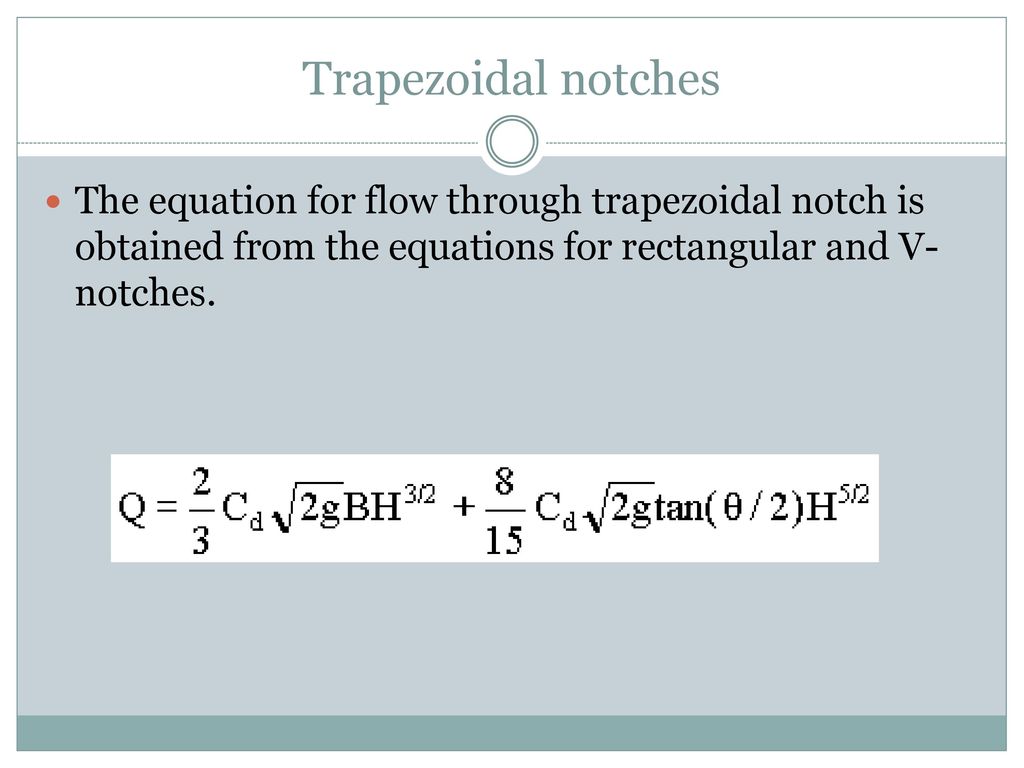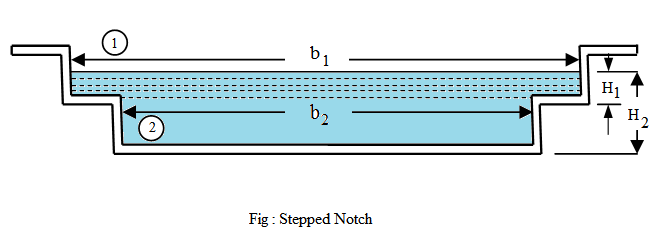Notches and Weirs- Their classification and types
Notch- is a device used for measuring the rate of flow or discharge of a liquid through small channel or tank.
Weir- is a concrete or masonry structure, placed in an open channel over which the flow occurs.
It is form of vertical wall , with the sharp edge at the top, running all the way across the open channel.
b) Triangular notch
c) Trapezoidal notch
d) Stepped notch
2. According to the effect of the sides on the nappe
a) Notch with end contraction
b) Notch without end contraction or suppressed notch
Weir are classified according to the shape of the opening, the shape of the crest ,the effect of the sides on the nappe and the nature of discharge
a) According to the shape of the opening:
1. Rectangular weir
2. Triangular weir
3. Trapezoidal weir
b) According to the shape of the crest
1. Sharp-crested weir
2. Broad-crested weir
3. Narrow-crested weir
4. Ogee-shaped weir
c) according to the effect of the sides on the emerging nappe
1. weir with end contraction
2. weir without end contraction
stay in your home to fight against COVID-19
Stay tuned ...
:)
Weir- is a concrete or masonry structure, placed in an open channel over which the flow occurs.
It is form of vertical wall , with the sharp edge at the top, running all the way across the open channel.
| Notches | Weirs |
1. A notch may be defined as an opening provided in one side of a tank or reservoir,with upstream liquid level below the top edge of opening.
|
1. A weir may be defined as a structure constructed across a river or canal to store water on the upstream side. |
| 2. The sheet of water flowing through a notch is called Nappe. | 2. The sheet of water flowing over a weir is called Vein. |
| 3. The bottom edge of a notch is called Crest. | 3. The bottom edge of a weir is called Sill. |
| 4. Usually made of metallic plates. | 4. Weir is a concrete or masonry structure |
| 5. Measures small discharge of small stream, lake or canal. | 5. It can measure large discharge of rivers and canals. |
| 6. Notches are of small size. | 6. Weirs are of bigger size. |
Notch
Weir
Classification of Notches and Weirs
Notches are classified as:
1. According to the shape of opening
a) Rectangular notchb) Triangular notch
c) Trapezoidal notch
d) Stepped notch
2. According to the effect of the sides on the nappe
a) Notch with end contraction
b) Notch without end contraction or suppressed notch
Weir are classified according to the shape of the opening, the shape of the crest ,the effect of the sides on the nappe and the nature of discharge
a) According to the shape of the opening:
1. Rectangular weir
2. Triangular weir
3. Trapezoidal weir
b) According to the shape of the crest
1. Sharp-crested weir
2. Broad-crested weir
3. Narrow-crested weir
4. Ogee-shaped weir
c) according to the effect of the sides on the emerging nappe
1. weir with end contraction
2. weir without end contraction
Discharge over a Rectangular Notch or Weir
The expression for discharge for Rectangular Notch or Weir is same
Consider a Rectangular Notch or Weir provided in a channel carrying water as shown in fig
Let H =Head of water over the crest
L=Length of Rectangular Notch or Weir
For finding the discharge of water flowing over the Notch or Weir ,consider an elementary horizontal strip of water of thickness dh and length L at a depth h from free surface of water
The area of strip=L*dh
And theoretical velocity of water flowing through the strip =√2gh
The discharge dQ through the strip is given by
dQ=Cd* area of strip *Theoretical velocity
=Cd*L*dh*√2gh
Cd = Coefficient of discharge
Q= 2/3* Cd * √2g* L* H ^1.5
Discharge over a Triangular Notch or Weir
The expression for discharge over a triangular Notch or Weir is same
Let H= Head of water above V notch
Q= 8/15* Cd* √ 2g*tan θ/2 * H៱5/2
Advantages of triangular Notch or Weir over Rectangular Notch or Weir
A triangular notch or weir is preferred over a rectangular notch or weir due to following reasons
1. The expression for discharge for a right angled V notch or weir is very simple.
2.For measuring low discharge ,a triangular notch gives more accurate results than a rectangular notch.
3. In case of triangular notch ,only one reading ie. H is required for the computation of discharge.
4. Ventilation of triangular notch is not necessary.
Discharge over a Trapezoidal notch or Weir
Trapezoidal notch is a combination of rectangular and triangular notch. Thus the total discharge will be sum of discharge through rectangular notch or weir and triangular notch or weir.
Let H =Head of water over the crest
L=Length of the crest of the Notch
Cd1= Coefficient of discharge for rectangular portion
Cd2= Coefficient of discharge for triangular portion
Q1=2/3* Cd * √2g* L* H ^1.5
Q2=8/15* Cd2* √2g* tan θ/2 * H៱5/2
Q=2/3* Cd * √2g* L* H ^1.5 + 8/15* Cd2* √2g* tan θ/2 * H៱5/2
Discharge over a Stepped Notch
A stepped notch is a combination of rectangular notches. The discharge through the stepped notch is equal to the sum of the discharges through the different rectangular notch
Q=2/3* Cd * √2g* b2* (H2^1.5-H1^1.5 ) + 2/3* Cd * √2g* b1* H1^1.5
Effect of Discharge over a Notch or Weir due to error in the measurement of head
- For rectangular notch
Q=2/3* Cd * √2g* L* H ^3/2
Q=K*H^3/2 where K= 2/3* Cd * √2g* L
Differentiating the above equation we get
dQ= K*1.5 H ½
dividing dq by Q
dividing dq by Q
dQ/Q= 1.5 dH/H
this tells that an error of 1% in measuring H will produce 1.5% error in Discharge
- For triangular notch
Q= 8/15* Cd2* √2g* tan θ/2 * H៱5/2
Q=K*H^5/2 where K= 8/15* Cd2* √2g* tan θ/2
Differentiating the above equation we get
dQ= K*2.5 H3/2
dividing dq by Q
dividing dq by Q
dQ/Q= 2.5 dH/H
this tells that an error of 1% in measuring H will produce 2.5% error in Discharge
Time required to empty a reservoir or a tank with a rectangular notch or weir
T=3A/(Cd L root 2g)*(1/H2 -1/H1)
Time required to empty a reservoir or a tank with a triangular notch or weir
T=5A/(4 Cd tan /2 root 2g)*(1/H2 -1/H1)
Velocity of approach
Velocity of approach is defined as the velocity with which the water approaches or reaches the weir or notch before it flows over it. Thus if Va is the velocity of approach then an additional head ha equal to Va2/2g due to velocity of approach, is acting on the water flowing over the notch. Then initial height of water over the notch becomes (H + ha) and final height becomes ha.
Then all the formula are changed taking into consideration of velocity of approach.
Va=Q/Area of channel
Empirical Formula for discharge over rectangular weir
Q=2/3 *Cd *√2g *L *[(H + ha)៱3/2 –ha ៱3/2]
Francis formula:He considered that the end contraction decreases the effective length of the crest of weir and hence decrease the discharge. Each end contraction reduces the crest length by 0.1*H, where H is the head over the weir. For a rectangular weir having two end contraction only hence effective length is:
L=( L- 0.2*H)
Q=2/3 *Cd *√2g *( L- 0.2*H) * H៱3/2
if Cd=0.623 g=9.81 m/s៱2 then
after simplifying
Q=1.84*( L- 0.2*H)* H៱3/2
If end contraction are suppressed ,then
Q=1.84* L* H៱3/2
If Velocity of approach is considered ,then
Q=1.84*L *[(H + ha)៱3/2 –ha ៱3/2]
Bazin formula: He proposed that
Q=m *L *√2g *H៱3/2
where m=2/3*Cd=0.405+0.003/H
Cipolletti Weir or notch
A standard Cipolletti weir is trapezoidal in shape The crest and sides of the weir plate are placed far enough from the bottom and sides of the approach channel to produce full contraction. The sides incline outwardly at a slope of 1 horizontal to 4 vertical.
tan θ/2=1/4
by giving this slope to the sides, an increase in discharge through the triangular portion ABC and DEF of the weir is obtained. If this slope is not provided the weir would be rectangular one, and due to end contraction,the discharge would decrease.
Q=2/3 *Cd *√2g *( L- 0.2*H) * H៱3/2
Q=2/3 *Cd *√2g * L *H៱3/2- 2/15* Cd * √2g * H៱5/2
due to end contraction the discharge decreases by 2/15* Cd * √2g * H៱5/2. This decrease in discharge can be compensated by giving such a slope that the discharge through two triangular portions i equal to 2/15* Cd * √2g * H៱5/2. On equating this decrease with the triangular notch discharge
2/15* Cd * √2g * H៱5/2= 8/15* Cd* √ 2g*tan θ/2 * H៱5/2
on solving we will get
tan θ/2=1/4
Thus discharge through Cipolletti weir is
Q=2/3 *Cd *√2g * L *H៱3/2
Discharge over a OGEE Weir
it is similar to rectangular weir hence
Q=2/3 *Cd *√2g * L *H៱3/2
That's for all for this blog
Thanks for reading till now
stay in your home to fight against COVID-19
Stay tuned ...
:)















Quite impressive
ReplyDelete